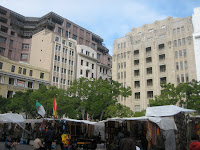A Young Life Lost
Today a little boy died. He was five years old. He was found in the township of Nyanga by a health worker and brought to the public hospital. For about a week, he was treated for severe malnutrition, AIDS, and all the other symptoms that come from being neglected. He was marked by the hospital social worker as “without family”. He was placed in a bed in the Peds section of the hospital. His limbs were grossly under weight and he was unable to keep food down the first few days. The CCS intern, placed at the hospital, was shocked by the little boy’s condition.
She shared her experience with our close-knit group. Last week, we all pulled together to lend her support when the boy was brought in. She elegantly coped with witnessing the pain of this young human being. With each day, she pushed to comfort him and encourage him to keep some food down. By the weekend, she was reporting that he was keeping food down and able to keep his eyes open. She asked me to look into activities that might help him feel more comfortable. With hope, she and I researched art therapy techniques for children with terminal disease and unique mobility needs. We were both working on creating a list of activities that might make this little boy feel loved and hopeful, but no amount of planning can prepare you for heart break.
After picking her up from the hospital today, she informed us that the little boy had passed away. I could see the tears in her eyes. She had worked so hard to be more than a doctor in training. She had worked to give the little one a sense of belonging. Even now, as I write, I can feel a pain in my own chest. A pain that makes me remember other young people that have died. A pain that leaves me wishing that I did believe in an after life. The sort of pain that comes from loss….the loss of a unfinished life.









